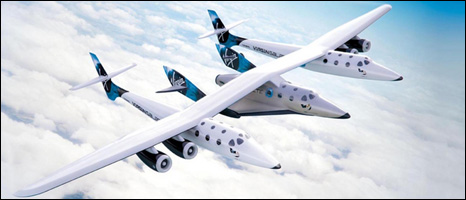[/caption]
The company that aims to be the first “spaceline,” by taking paying passenger to space on a regular basis is also looking at contributing to science, too. Virgin Galactic is looking at the possibility of carrying scientific instruments on board the aircraft that brings its spaceship skyward. Richard Branson is teaming up with the US National Oceanic and Atmospheric Administration (NOAA) to gather information about atmospheric composition and particularly greenhouse gases. NOAA is interested in flying atmospheric monitoring instruments on the carrier vehicle WhiteKnightTwo, because it will be in regular flight above 50,000 ft for the next year-and-a-half during its test-flight period. “Almost everything NOAA does at the moment is at 25,000ft (7,600m) maximum altitude. It’s quite difficult to find research aircraft that do atmospheric testing above that,” said Will Whitehorn, president of Virgin Galactic.
“One of the things that we as an airline operator know is that the tropopause is rising slightly. That has had quite an effect on aircraft flying in the upper atmosphere and the amount of turbulence they get. This is probably related to the mix of greenhouse gases and the levels they are rising to that’s moving the tropopause up,” said Whitehorn to journalists at the International Astronautical Congress (IAC) in Glasgow.
SpaceShipTwo will be carried to about 15,200 m (50,000 ft) by the WhiteKnightTwo aircraft. The spaceship then ignites a rocket engine, taking passengers to a maximum altitude of 110 km (68 miles).
The vehicle would carry three instruments. One is going to measure CO2 and methane in the atmosphere. The second will take “flask samples”, allowing it to test for a much wider range of gases. These samples will be offloaded from the aircraft and taken to NOAA’s laboratories in Boulder, Colorado.
The third experiment will carry a tube sample, which empties of gases on the way up to high altitude and fills up on the way down.
Mr Whitehorn said that when SpaceShipTwo began flying, it could provide NOAA with regular sampling of gases through the outermost region of the atmosphere – known as the ionosphere – up to 110km above Earth.
This would be important for calibrating data from a major satellite mission called the Orbiting Carbon Observatory (OCO), which is designed to measure atmospheric carbon. The joint NOAA-NASA mission is due to launch next year.
The early part of the agreement between Virgin Galactic and NOAA is on a “no exchange of funds” basis, said Whitehorn, because it was currently classified as an experimental program.
SpaceShipTwo is currently 60% complete. The company plans to unveil the finished craft next summer. Virgin Galactic said 280 customers have signed up for flights to the edge of space.
Source: BBC


While I applaud Virgin Galactics interest in doing some real science during the upcoming test flights, whatever happened to NASAs U-2 & Learjet aircraft which regularly do research flights of 50,000 ft (Learjets) to 80,000+ ft. (U-2) for stratospheric research & meteoric dust collection. True, this would give NOAA more space for their specific upper atmospheric experiments, but they already collaborate with NASA for these type of missions. Maybe this is seen by NOAA as a cost-effective way to gather this type of data, as I’m sure operation of the U-2 is costly to NASA (and of course the taxpayers).
That’s awfully nice of them, really. Good advertising, of course, but still. Always happy to have more science done.
Another example of the public sector working with and benefiting from the private sector. And as a bonus, it saves me some tax dollars.
Can’t wait for Tier three success with Spaceship Three.
Okay, yeah, nice. But SpaceX’s orbital insertion stills outrocks this joyride machine.
“Okay, yeah, nice. But SpaceX’s orbital insertion stills outrocks this joyride machine.”
But which one do you have a better shot at *getting* a ride on? A suborbital reuseable you can ultimately buy a ticket on, trumps (in this case) an orbital ELV that you can’t ride at any price…
Even when Falcon-9/Dragon is up an running, ‘buying’ an entire flight is certain to run more than the $200k or so that Virgin wants.
Still, I’ll applaud any and every NewSpace advance that happens.
I’m in an income bracket that can barely keep this internet connection going, I would have to say the chances of me riding either machines EVER is the same was all of the molecules of air moving to one side of the Earth and staying there for 24 hours.
It *is* possible but not likely in a googleplex of years.
“It *is* possible but not likely in a googleplex of years.”
For you and I, yes. But a commercially signifigant number of people *do* have $200k to spend on themselves this way. Enough, but not so many have $20M to go to ISS.
Without early adopters like them showing there’s a market, we can’t hope it’ll ever come within our reach. So the sooner such things begin, the better.
And still, no one rides a Falcon-1 at any price. Each is important, in its own way.